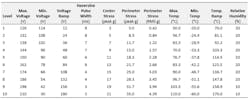Addendums to LED-lamp Caliper research by the US Department of Energy shows that PAR38 products are more robust to harsh environments than legacy products and that dimming remains inconsistent in A-lamps.
PAR38 ruggedness
The new PAR38 research is yet another addition to the DOE's Series 20 PAR38 retrofit lamp research. The original Series 20 report came out in December 2012 and documented baseline performance and cost relative to legacy PAR38 bulbs. The most recent addendum published in April 2014 focused on dimming.
The latest Report 20.3, "Robustness of LED PAR38 lamps," covers the testing of 32 LED retrofit lamps and 8 legacy benchmark bulbs. The DOE tested three samples of each product, putting the products through what the agency called multi-stress testing. Specifically, the research team exposed the lamps to increasing levels of humidity, thermal, vibration, and electrical stress.
In general, the DOE reports that the LED lamps proved more robust to the stress testing than did the legacy lamps. But there was broad variation in the results. The test procedure subjected the products to ten step changes in stress levels as show in the nearby table. Some of the LED retrofit lamps failed after one or two levels while others were able to withstand all ten levels.
None of the legacy lamps proved capable of operating past level three with the exception of a single halogen lamp that reached level seven. On the other hand, more than 20 of the LED lamps matched or exceeded that halogen lamp. To see the complete results, view the full report on the DOE SSL website.
Consumer targeted lamps
Moving to the second new report, the DOE released the "Caliper retail lamps study 3.1: Dimming, flicker, and power quality characteristics of LED A lamps." The report is a follow-on to the general "Retail lamps study 3" published a year ago.
The new A-lamp research studied 14 LED lamps and the observed performance when controlled by four widely-available phase-cut dimmers. The report reached three general conclusions. A dimmer impacts the output of any lamp even at full scale setting. There are vast differences in dimmers. And the performance of LED lamps at different dim levels is less predictable than with incandescent lamps.
Still, the research digs far deeper. The LED lamps generally produce more light output than halogen and incandescent lamps at similar settings on a dimmer. The LED products do maintain a significant efficacy advantage over legacy lamps throughout the dimming range. But the dimming curve of LED products range from linear to incandescent-like.
Of course, flicker remains of very high interest due to the inherent dangers of the phenomena for some susceptible people. The DOE reports that half of the tested LED lamps produced the same or less flicker than the incandescent benchmarks. Unfortunately, some of the lamps in the other half of the sample set exhibited flicker that the DOE characterized as "similar to that of a magnetically ballasted fluorescent lamp."
In terms of power quality or impact on the AC power grid, all of the LED lamps met the power factor (PF) and total harmonic distortion (THD) requirements of ANSI C82.77-2002. For more details, see the full report on the DOE SSL website.







